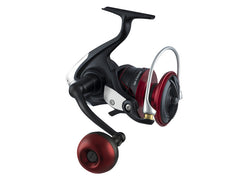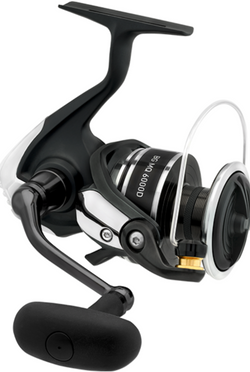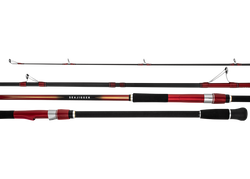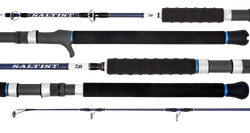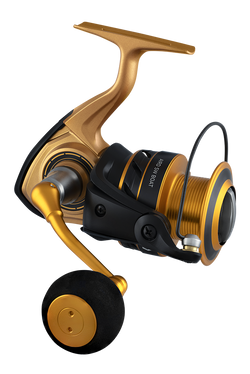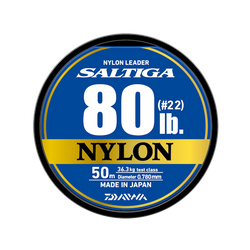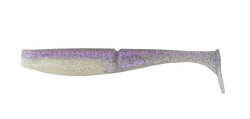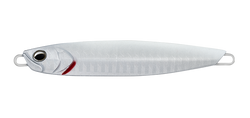The Complete Guide To Rock Fishing
Rock fishing refers to the activity of fishing from rocky coastal areas or shorelines rather than from a boat or pier. Anglers engage in rock fishing by casting their lines into the water from rocky platforms, cliffs, or other coastal structures. It can be a popular and challenging form of fishing, but it also comes with specific safety considerations due to the potential hazards associated with fishing in such environments, such as slippery rocks, strong waves, and unpredictable weather conditions. It's important for individuals participating in rock fishing to be aware of safety regulations and take necessary precautions to prevent accidents or injuries.
Another good aspect of rock fishing is that it can be done through any month of the year and if it’s not the right season for one species, then something else is sure to be biting. For pure reliability though, it’s hard to beat the cooler months, from late autumn through to early spring.
Early mornings or later in the afternoon are often more productive than through the middle of the day. It's also important to factor in the tides, as a low to rising tide is when most fish actively look for food, rather than a falling tide.
Fresh is best when it comes to bait with prawns, crabs, squid, octopus, strips of fish flesh, cunjevoi, green sea lettuce or cabbage and plain white bread all effective baits. Some of these are available around the rocks where you’re fishing, while others need to be purchased.
Rock fishing is legal in all states and territories in Australia. However in NSW it is mandatory per NSW Rock Fishing Safety Act 2016 to wear a suitable life jacket when engaging in rock fishing within a designated area. This requirement applies to both adults and children, as well as anyone assisting in the fishing activity. Failure to wear an appropriate lifejacket in a declared area may lead to a $100 on-the-spot fine.
SYDNEY SNAPPER OFF THE ROCKS || SENSOR SURF 45 SCW
While we see a lot of lure fishing in the fishing media these days, the truth is many Aussies love getting back-to-basics and trying their luck with traditional or old school angling. Rock fishing is a great place for this back-to-basics fishing.

Choose the Right Time and Place
Target late autumn to early spring for rock fishing along Australia's east coast. Safe Spots: Select dry ledges with constant whitewash, ensuring a safe and enjoyable fishing experience.
Gear Up Wisely
Choose longer rods in the 9-13 feet range (2.7 to 4 metres) to prevent line snags and enhance casting distance. Reel Recommendations: Opt for spinning reels (4000 to 6000 size) for their ease and versatility. Line Choices: Consider mono in the 10-20lb range (5 to 10 kilograms) for bait fishing and braid for more experienced anglers.
Master Your Bait and Lure Game
Utilise blue pilchards, prawns, crabs, octopus, squid and fresh fish flesh for a variety of rock-dwelling species. Lure Choices: Tie on chrome metal lures (20-45 grams) and soft plastics (3-5") for versatility, and add excitement with surface poppers and stickbaits.

Safety First
Always check weather forecasts before heading out to avoid unexpected challenges. Footwear Matters: Wear appropriate footwear, such as rock fishing booties or grippy Dunlop Volleys. Swell Awareness: Steer clear of swells exceeding two to three metres for a safe rock fishing experience.
Time Your Moves
Plan your fishing trips for early mornings or late afternoonsduring a low to rising tide for increased success.
Adapt to Seasonal Patterns
Tailor your approach based on the season—winter for salmon and tailor, spring for increasing kingfish numbers, and late January to April for bonito, kings, frigate mackerel, and mack tuna dominance.
Rock fishing is a great time and can lead to some epic catches, but it's important to remember that safety is paramount. Don't get caught out and exposed to dangerous swells by following these safety tips.
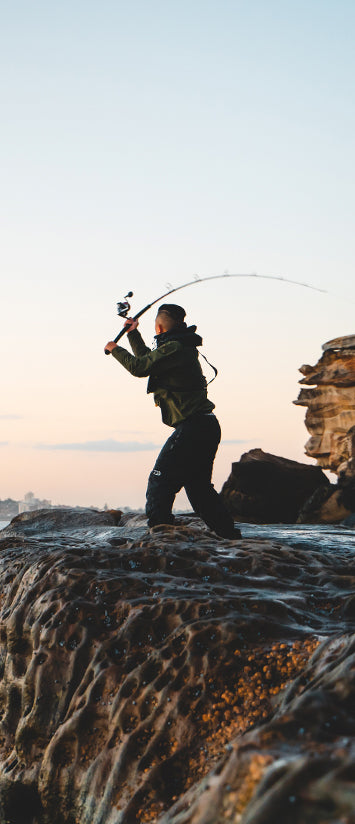
Prioritising Safety
Rock fishing is recognised globally as one of the most perilous recreational activities, as a result safety takes precedence in rock fishing. A fundamental rule echoes through the community: never turn your back on the ocean. Many anglers opt for fishing in pairs, providing an extra set of vigilant eyes. This practice is recommended for rock fishing newbies.
Pre-Session Observations
A safety-oriented approach involves pre-session observations from a high vantage point, evaluating wave patterns, swell size, and tidal movements. Understanding these conditions and identifying safe exit points in case of a fall are integral to a secure rock fishing experience. In the event of a wash-off, a strategic, calm response, swimming in the direction of the swell and toward the sand if safe, aligns with the safety-first ethos upheld by rock hoppers.
Non-Fishing Essentials
In addition to fishing equipment, certain non-negotiable safety essentials are indispensable for rock fishing. A thin, unobtrusive life jacket is recommended, paired with high-visibility clothing featuring reflective strips. Steel-spiked boots emerge as essential to prevent slipping on the often slippery and uneven rock surfaces. In specific areas of NSW, life jackets are mandatory for rock fishing, underscoring the gravity of safety measures.
Winter Swell Dynamics
Winter introduces fluctuating conditions, transitioning from calm, flat seas to massive and treacherous swells. This variability, influenced by winter weather patterns, impacts the popular rock fishing areas along the east coast.
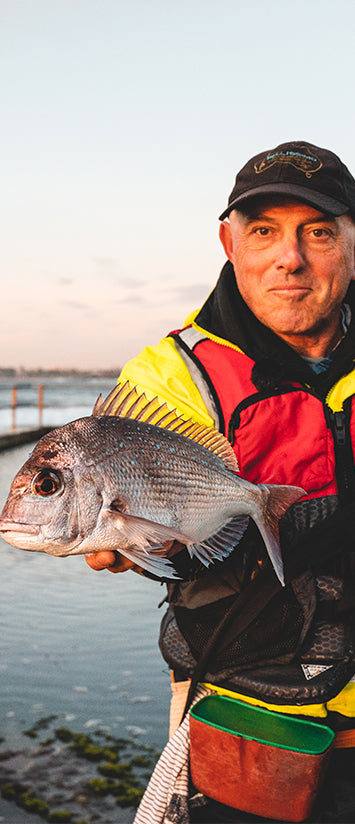
Flat Seas vs. Big Swells
Extended periods of robust westerly winds and large high-pressure systems contribute to flat seas. These offshore winds subdue wave action, creating a serene environment for rock fishing. Conversely, low-pressure systems, including notorious east coast lows, generate substantial swell. These systems, whether near the coast or in the Tasman or Coral Seas, produce ground swell, potentially deceptive in masking hidden dangers.
Choosing Safe Spots
During periods of powerful surfconditions, anglers are advised to steer clear of rocky areas or fish smaller, sheltered spots protected by natural features. These secluded spots often become havens for fish seeking refuge from the turbulent open ocean, providing opportunities for feeding on items like crabs washed away from more exposed locations.
Adapting to Flat Conditions
Conversely, during periods of dead-flat seas, safety in rock fishing retains its paramount status. While conditions may be safer, common targets like bream, drummer, luderick, salmon, and tailor become more cautious and challenging to catch. Anglers are advised to focus on areas with a small amount of whitewash close to the rocks, where fish feel secure and are more likely to feed.Adapting strategies to flat conditions involves using lighter lines, longer and finer leaders, opting for top-quality bait, and judiciously employing berley. Additionally, choosing to fish during the early morning, late afternoon, or overcast skies enhances the likelihood of success compared to the challenges posed by bright midday sunlight.
Before you head out to the rocks you'll need to make sure you got the right gear to get the job done. We've hand picked some Daiwa products that we love to use on the rocks.
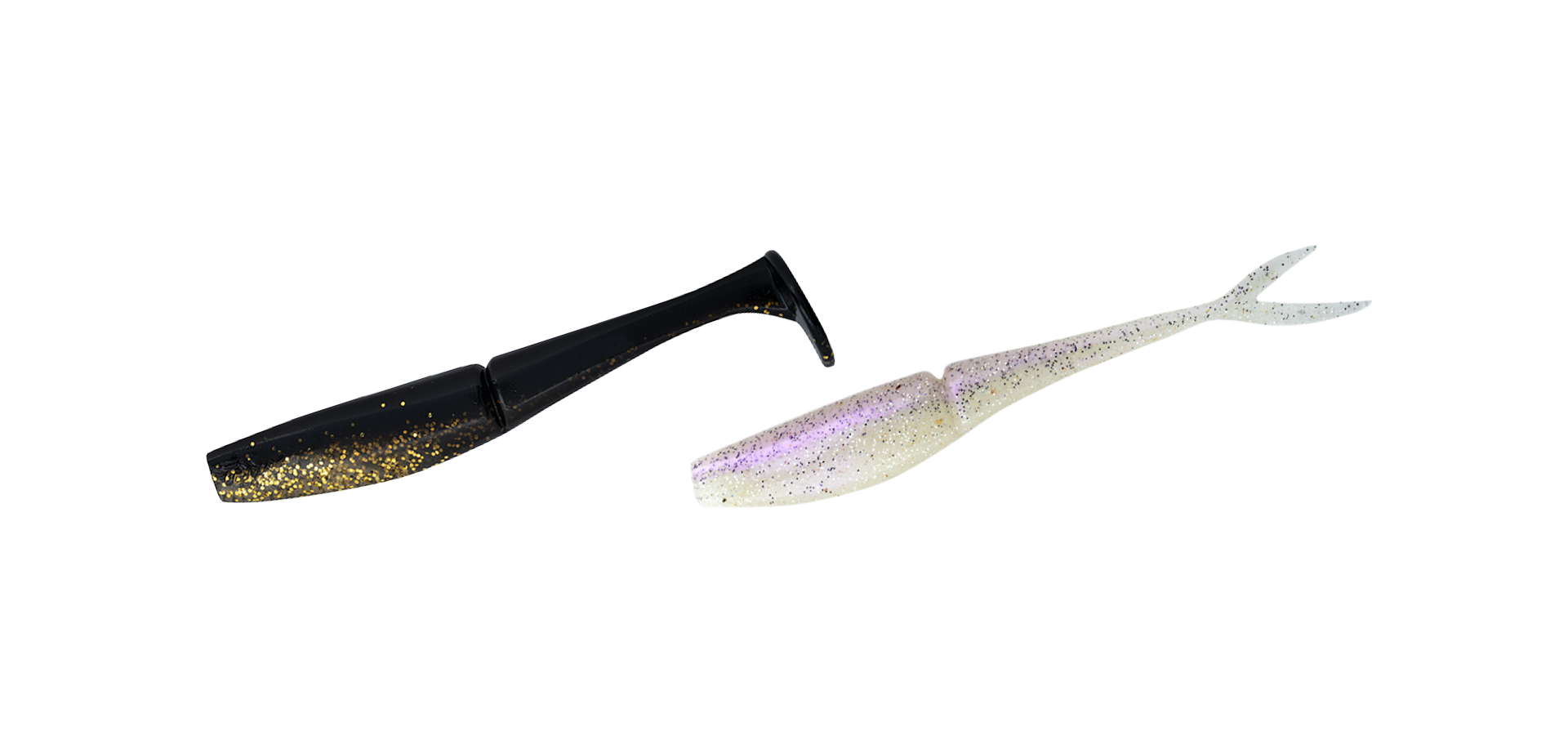
Choosing the Right Baits:
Plenty of effective baits attract fish around the rocks, with blue pilchards, whole or cut, being excellent for bream, salmon, tailor, trevally, and snapper. Other top baits include prawns, octopus, crabs, fresh fish flesh strips, cunje, green sea lettuce or cabbage, and plain white bread. Availability varies, with some found around the rocks and others requiring purchase.
Lures For Rock Fishing:
For those eager to try lures off the rocks, simple chrome metals between 20 and 45 grams are a great place to start. Pelagic predators such as tailor, salmon, and bonito will rarely refuse a fast paced metal presentation.
A variety of other lures will also work of the rocks with soft plastics in 3-7" size range hard to go past on a variety of different species.
Surface poppers and 'walk the dog' style stickbaits are also worth considering, particularly during sunrise or sunset when pelagic species such as tuna and tailor are about.
Commercially Available Baits:
Anglers are spoilt for choice when it comes to store bought bait options, with your local tackle outlet generally providing a host of options. Blue pilchards, especially when used whole on ganged hooks, are unbeatable for catching tailor or salmon. Cut sections of pilchards work well for bream, trevally, and pan-sized snapper. Quality is essential when purchasing pilchards. The humble prawn and squid is a versatile and omnipresent bait suitable for bream, drummer, trevally, and even luderick at times.
Gearing Up for Rock Fishing:
Choosing the right gear for rock fishing depends on the target species and terrain. Rock fishing tackle is typically heavier and longer than normal, facilitating the hauling of fish onto the ledge, often with the assistance of a wave. For pursuits like rock blackfish and wash fishing for snapper, a recommended outfit is Daiwa's Sensor Sandstorm 1062MH paired with a Saltist MQ, BG MQ or BG reel in 4000, 5000 or 6000 size.
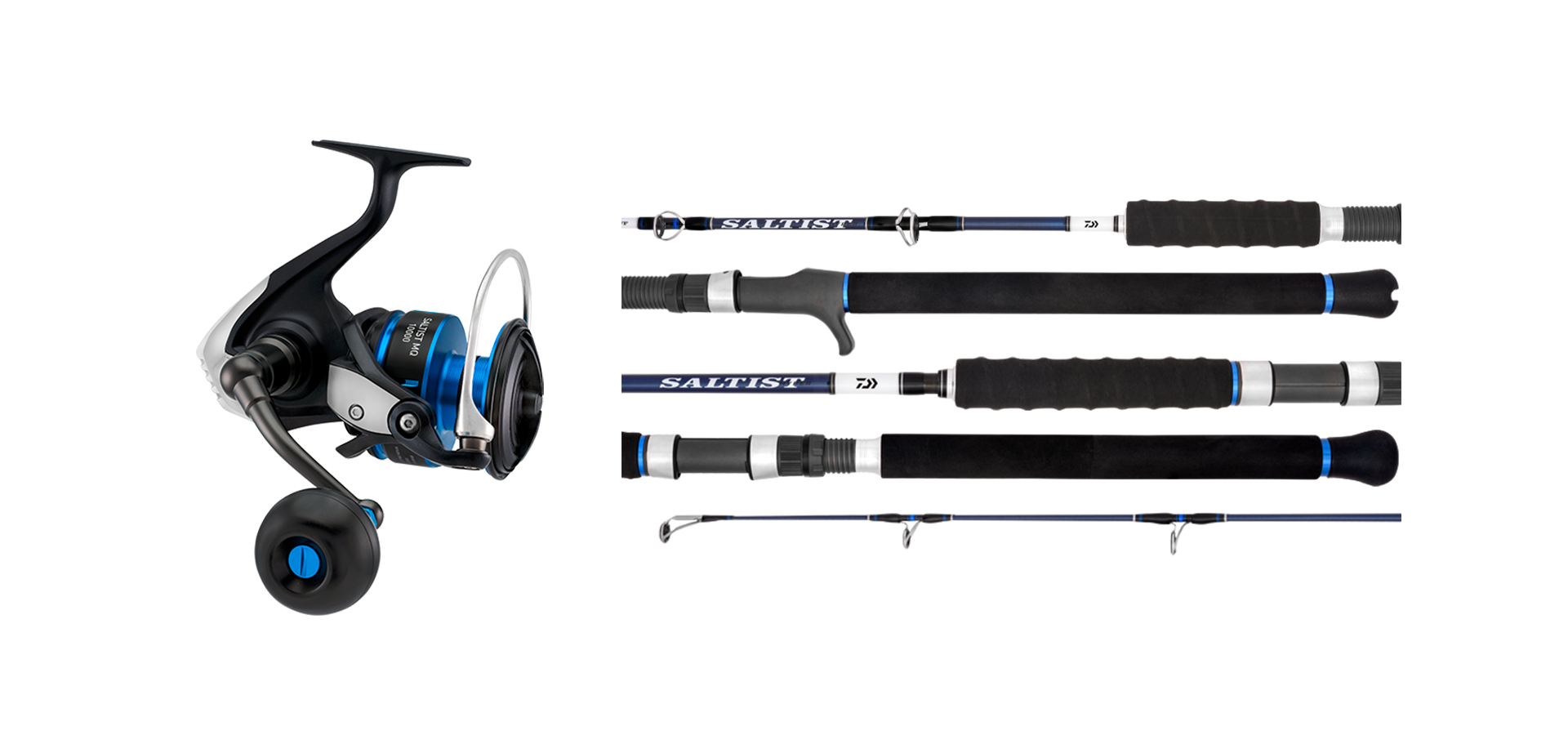
Optimal Rods for Varied Pursuits:
Selecting the right rod for rock fishing is crucial, some anglers employs different outfits tailored to target a variety of species. For rock blackfish (pigs) and wash fishing for snapper, the Daiwa Sensor Sandstorm 1062MH rod proves effective, offering a combination of lightness and power. Meanwhile, for tackling heavier species like kings and tuna the 23 Seajigger 1082H and 23 Sensor Surf 1503XH are both suitable choice.
Essential Reels for Versatility:
Choosing the appropriate reel is vital in rock fishing. Daiwa offers a host of suitable options with the Saltist MQ, BG MQ and longtime favourite, the BG, in sizes 4000-6000 sizes all proven rock fishing reels. These reels offer the necessary power and versatility for various rock fishing scenarios. Choose the reel size to match the amount and size of line being used and that best balances with your rod.
Tackle Considerations:
In terms of tackle, longer rods in the 9-13 feet range (2.7 to 4 metres) are favored, providing advantages in preventing line entanglement and enhancing casting distance. The use of nylon mono lines, ranging from four to ten kilos, is common among experienced rock hoppers. Threadline or spinning reels, particularly in sizes 4000 to 6000, are preferred for their ease of use and adaptability to different rock fishing situations.
Comprehensive Kit for Success:
To round out the rock fishing kit, including a variety of hooks (sizes 6 to 4/0), sinkers, swivels, and metal lures ensures readiness for targeting different fish species. Ganged hooks in sizes 4/0 or 5/0 are effective for baits like whole pilchards. Additional accessories such as rubber float stops, lumo beads, and a small mesh keeper net contribute to a well-equipped setup. As anglers gain experience, the inclusion of braid lines with a nylon mono or fluorocarbon leader provides increased versatility and sensitivity for bites.

